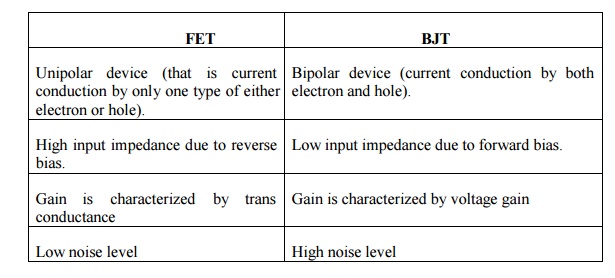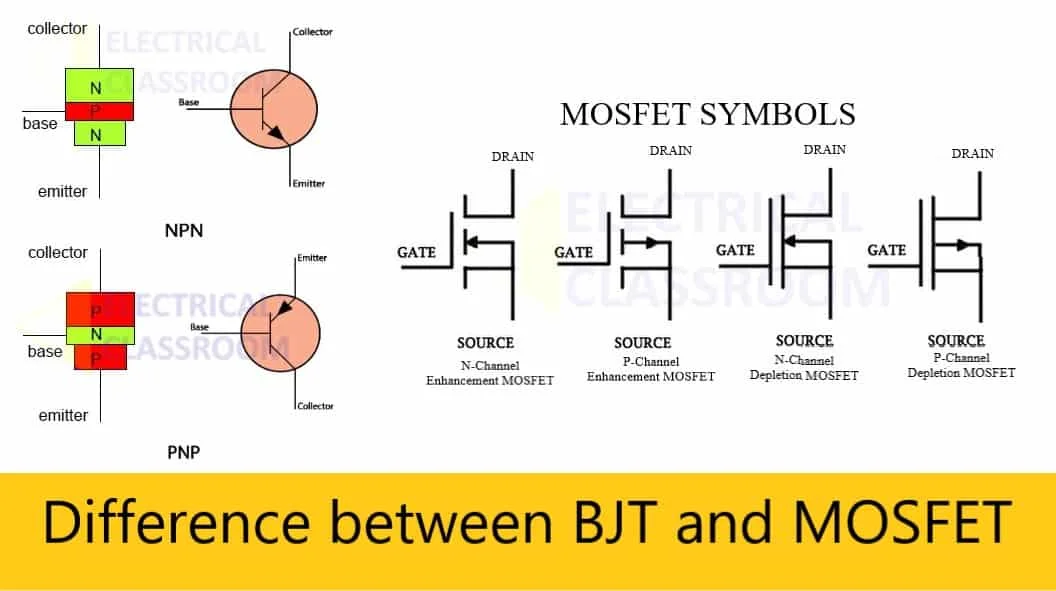In contrast the saturation and cut-off regions allow bipolar transistors to be used as switches because there is little electrical resistance between emitter. In FET the current is transfered only using holes or electrons.

Hardik Patel Jatin Patel Ppt Video Online Download
As against JFET is majority carrier device thus termed as unipolar.

. Easily damaged by static electricity. Higher On state losses reduced efficiency when ON 2. Answer 1 of 2.
The mosfet has a very low power loss and a high speed. While both have three terminals these differ. A bipolar device as it contains a p-n junction in the conducting path.
It depends of type of FET. As the name suggests two poles ie. In FET we use only electrons or holes not both.
The main difference between BJT and FET is that BJT is a type of bipolar transistor where the current involves a flow of both majority and minority carriers. The three terminals of the BJT are the base the collector and the emitter. It is so because the operation of BJT is dependent on injection and collection of minority carriers that includes both electrons and holes.
Therefore an amplifier circuit can be configured using the active area. MOSFETs are ideal for high-power applications whereas BJTs are more. And they perform like a current amplifier.
You should include a diode regardless of whether you use the BJT or MOSFET. Both the electrons and holes contribute i. The MOSFET has a source drain and gate whereas the BJT has a base emitter and collector.
It is a current controlled device. Transistors are semiconductor devices that can be used as amplifiers or switches in electronic circuits. You could drive the coil directly from the MOSFET if it is rated sufficiently for the current but if you want to leave Q1 as is I suggest you rearrange it to put the coil at the collector.
All FETs can be called UNIPOLAR devices because charging carriers carrying the current through the device are all of the same type that is either holes or electrons but not both. The terminology stems from the charge carriers involving current flow in the device. This distinguishes FETs from bipolar devices in which both holes and electrons are responsible for the current flow in any device.
However we would obviously love a device that has advantages of both the above mentioned devices. Has a secondary breaking. A BJT is a type of transistor that uses both.
Current for the critical load flows through drain and source which is controlled by a voltage applied to the gate. See answer 1 Best Answer. There are many more benefits try a google and.
It is a low-voltage high-current device. Mosfet provides a very good isolation between the gate and the other two terminals compared to bjt. When a bipolar transistor is in the active region the collector current is basically h FE times the base current.
Unipolar transistor has three terminals drain source and gate. A bipolar junction transistor uses a low base current for operating a larger collector current. Voltage signals can easily operate a mosfet so it is used in many digital circuits.
BJT is called bipolar because the current in a BJT flows due to both electron and hole carriers whereas the current in a Field Effect Transistor FET flows due to either electron carriers for N-type FET or hole carriers for P-type FET hence theyre called. It is a high-voltage low- current device. Lower Switching rates since unipolar.
In contrast FET is a type of unipolar transistor where only the majority carriers. FETs are sometimes called unipolar transistors to contrast their single-carrier-type operation with the dual-carrier-type operation of. A Bipolar Junction Transistor also known as a BJT or BJT Transistor is a three-terminal semiconductor device consisting of two p-n junctions which are able to amplify or magnify a signal.
Can be switched on and off faster Cons. The crucial difference between BJT and JFET is that BJT is a bipolar device whereas JFET is a unipolar device. It doesnt have anything to do with the junction.
The MOSFET voltage controlled is a metal-oxide semiconductor whereas the BJT current controlled is a bipolar junction transistor. I changed the resistor to 47k as I think 68k might be too high but it will. And hence the Insulated Gate Bipolar Transistor IGBT was born.
A unipolar transistor is a FET that uses only one type of charge either electron n-channel FET or hole p-channel FET for conduction from drain to source. Either electrons or holes for the operationThese do not have any junction as they are made up of either N-Type or P-type. Answer 1 of 2.
MOSFET can handle more power compared to BJT. A bipolar junction transistor includes a stable saturation voltage drop like 07 V whereas the MOSFET includes a 0001-ohm on-resistance that leads to fewer power losses. FETs can be called UNIPOLAR devices because the charge carriers that carry the current through the device are all.
True BJT is called bipolar because of presence of holes and electrons. They use a single charge carrier ie. Cannot handle higher voltages.
High Input Impedance. When you apply some voltage on its gate you will just change the resistance of chanal.

Main Difference Between Mosfet And Bjt Etechnog

Transistor Bipolar And Unipolar Electrostudy


0 Comments